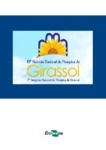Please use this identifier to cite or link to this item:
http://www.alice.cnptia.embrapa.br/alice/handle/doc/910270| Title: | Consórcio de girassol com milho e feijão no agreste Sergipano. |
| Authors: | RODRIGUES, C. S.  OLIVEIRA, I. R. de   CARVALHO, H. W. L. de   CARVALHO, L. M. de   CASTRO, C. R.   MENEZES, V. M. M.   CARVALHO, C. G. P.   |
| Affiliation: | CINTHIA SOUZA RODRIGUES, PIBIC/CNPq - Embrapa Tabuleiros Costeiros; IVENIO RUBENS DE OLIVEIRA, DTT; HELIO WILSON LEMOS DE CARVALHO, CPATC; LUCIANA MARQUES DE CARVALHO, CPATC; CAMILA RODRIGUES CASTRO, CPATC - PIBIC/CNPq; VANESSA MARISA MIRANDA MENEZES, CPATC - PIBIC/CNPq; CLAUDIO GUILHERME PORTELA CARVALHO, CNPSO. |
| Date Issued: | 2011 |
| Citation: | In: REUNIÃO NACIONAL DE PESQUISA DE GIRASSOL, 19., 2011, Aracaju. Anais... Londrina: Embrapa Soja Aracaju: Embrapa Tabuleiros Costeiros, 2011. |
| Pages: | p. 202-205. |
| Description: | Este trabalho teve por objetivo conhecer a adaptabilidade de cultivares de girassol no Agreste de Sergipe, para dotar a agricultura regional de cultivares superiores que sejam indicados ao cultivo consorciado com milho e feijão no Agreste sergipano. Foram utilizadas 20 cultivares de girassol: NTO 2.0, NTO 3.0, AGUARÁ 4, AGUARÁ 6, M 734, BRS 321, BRS 322, BRS 323, BRS G 26, OLISUN, PARAISO 22, PARAISO 33, PARAISO 65, HELIO 251, HELIO 253, HELIO 863, BRS 324, EMBRAPA122, MULTISSOL e CATISSOL cultivadas em monocultivo, consórcio com milho e consórcio com feijão. No consórcio com milho foi utilizado o híbrido 2B587 e no consórcio com feijão foi utilizado a variedade carioca BRS Requinte. Foi avaliado o peso dos aquênios, sendo estabelecido o rendimento de grãos de cada cultivar de girassol em cada um dos sistemas. Foram verificadas diferenças significativas entre as cultivares avaliadas no monocultivo, consórcio com milho e consorcio com feijão. Na média, os rendimentos de grãos foram de 2.209 kg/ha, em monocultivo, 2.379 kg/ha em consórcio com feijão e 1.583 kg/ha, em consórcio com milho. O consórcio com feijão foi mais favorável ao cultivo do girassol tanto em relação ao monocultivo como em relação ao consórcio com milho. Foi observado que as cultivares de girassol apresentaram respostas diferenciadas quando submetidas a sistemas de cultivos distintos. O rendimento médio de grãos de girassol, na média dos sistemas de plantio adotados, foi de 2.057 kg/ha. As cultivares NTO 3.0, AGUARÁ 4, AGUARÁ 6, NTO 2.0, OLISUN, M 734, HELIO 253 e PARAISO 33 tiveram rendimentos acima da média geral, demonstrando melhor adaptação e por isso podem ser indicadas como opções de cultivo para a região Agreste de Sergipe tanto em monocultivo quanto em consórcios. Intercropping of sunflower with corn and bean in the agreste (sub- humid) Region of Sergipe. This work was carried out to determining the adaptability of sunflower cultivars in the Agreste Region of Sergipe. Were utilized 20 cultivars of sunflower: NTO 2.0, NTO 3.0, Aguará 4, Aguará 6, M 734, BRS 321, BRS 322, BRS 323, BRS G 26, OLISUN, Paraiso 22, Paraiso 33, Paraiso 65, HELIO 251, HELIO 253, HELIO 863, BRS 324, EMBRAPA122, MULTISSOL and CATISSOL cultivated in monocrop and intercropped with corn and bean. The hybrid 2B587 was used in the intercropping with corn. The variety BRS Requinte was used in the intercropping with bean. It was evaluated the weight of the grains. It was established the grain yield of each sunflower cultivar in each system. There were significant differences between cultivars in monocrop, intercropping with corn and intercropping with bean. On average, the grain yields were 2,209 kg/ha in monocrop, 2,379 kg/ha in intercropped with bean and 1,583 kg/ha in intercropping with corn. The intercropping with bean was more favorable to the sunflower cultivation in relation to the monocrop and to intercropping with corn. It was noted that sunflower cultivars showed different responses when subjected to different cropping systems. The average of sunflower yield in the mean of the cropping systems adopted, was 2,057 kg/ha. The Cultivars NTO 3.0, Aguará 4, Aguará 6, NTO 2.0, OLISUN, M 734, HELIO 253 and PARAISO 33 had yields above the general average, showing better adaptation and those can be indicated as options for the cultivation in the Agreste region of Sergipe state, in monocrop and in intercropping. |
| Thesagro: | Girassol |
| Type of Material: | Artigo em anais e proceedings |
| Access: | openAccess |
| Appears in Collections: | Artigo em anais de congresso (CNPSO)  |
Files in This Item:
| File | Description | Size | Format | |
|---|---|---|---|---|
| 202205.pdf | 6.29 MB | Adobe PDF |  View/Open |









